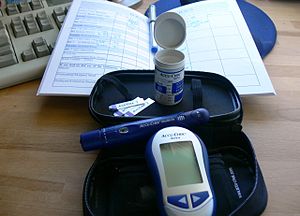
Diabetes mellitus is a syndrome characterized by elevated blood glucose concentrations (hyperglycemia) and disrupting metabolism.
Classification:
recognize three main forms of diabetes: type 1, type 2 and gestational (pregnancy). The most common forms of diabetes are type 1 and type 2 diabetes. Term type 1 diabetes has replaced many old terms such as juvenile diabetes and insulin-dependent diabetes. Similarly, the term type 2 diabetes has replaced the old names, including insulin dependent diabetes (non insulin dependent).
Type 1 diabetes:
Type 1 diabetes is characterized by destruction of insulin-producing pancreatic beta cells of the islets of Langerhans in the pancreas leading to insulin deficiency . Main cause is an autoimmune reaction mediated by T lymphocytes type 1 diabetes accounts for about 10% of diabetes cases in Europe and North America. Most patients experience the onset of full health , often in childhood (although it can occur at any age) . Insulin sensitivity is normal especially in the early stages .
A hormone called insulin allows body cells to use glucose as an energy source . When insulin secretion is insufficient or when the insulin does not fulfill its role in the body , the condition is called diabetes. Diabetes can be kept under control through careful monitoring of diet and weight and exercise as a supplement to medical treatment .
By digesting some foods with carbohydrates are converted into sugar (glucose , specifically ) faster than others. They have a high glycemic index . Diabetics should opt for foods that are digested more slowly. Fat and protein intake may decrease the glycemic index of a meal. See dietitian or doctor before you change your diet.
- Very low glycemic index foods : green vegetables , beans , nuts , cheese , butter , soy , lentils , fish, eggs , shellfish , barley, meat, fruit ;
- Low glycemic index : baked beans , peas, chickpeas, black beans , sweet potato , nuts , sweet corn , apples , oranges , grapes , yogurt , pears, rye bread , pasta, oatmeal ;
- Moderate glycemic index : watermelon , beets , bananas, raisins, white bread and whole , rye crackers , mussli , rice , sugar crystallized ;
- Very high glycemic index : honey, puffed rice , corn flakes , rice cakes , carrots , sticks, parsnips , potatoes .
Type 2 diabetes:
Type 2 diabetes is due to increased insulin resistance of tissues , accompanied by decreased insulin secretion . The lack of response of tissues to insulin is most likely due to modification of the insulin receptor on the cell membrane .
Type 2 is treated with oral medication for a long period of time, it requires external supply of insulin only when oral therapy is not effective in controlling blood glucose levels ( Type 2 is characterized by a high insulinemia ( compensatory effect ), which leading in time to the secretion of endogenous capacity is exhausted , new oral medication which raises the sensitivity of cells to insulin tend to protect the position of the discharge, in contrast with the contrary , it bases its action on boosting ) .
Factors that can cause type 2 diabetes include: sedentary mode of life and modern dietary caloric abundance , which resulted in obesity and even high body mass index , tobacco smoking , an increase in cholesterol levels , blood pressure (pressure ) high blood pressure .
Complications:
All types of diabetes have similar symptoms and complications . Hyperglycemia can lead to dehydration , and necorijată a period measured in weeks or months at ketoacidosis. Complications of long-term ( " late " ) are of vascular and neurological . Vascular problems are of two types : macrovascular and microvascular , macrovascular ones are represented by cardiovascular disease ( heart attack, angina ) and stroke (CVA ) are microvascular diabetic nephropathy problems ( severe renal disease ) and diabetic retinopathy ( problem consists in a continuous and sometimes brutal deterioration of the retina, which can lead to blindness ) . All such microvascular impotence is caused by uncontrolled diabetes , as part of diabetic foot problems , which is manifested by a slow healing wounds on extremities, recurrent infections and difficult to treat gangrene with risk of amputation, etc. . Another category of late complications of diabetes are neurological ones , namely diabetic neuropathy . This is manifested by loss of sensation , feeling and legs (feet ) and neuropathic pain ( pain sensations , burning , standing without immediate external causes ) neurological complications also , at least in part , also a microvascular etiology .
Epidemiology:
The number of people with diabetes has doubled in the last three decades, a study estimating that in 2011 there were 347 million diabetics worldwide [2], compared to how many there were 171 million in 2000. [3]
No comments:
Post a Comment